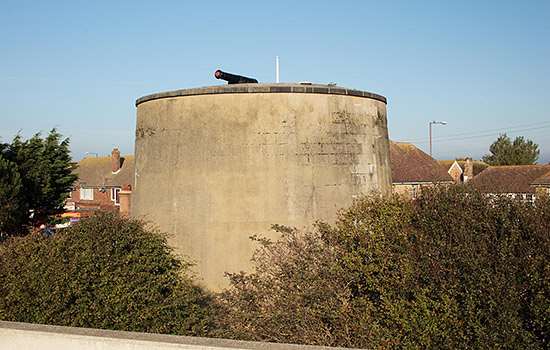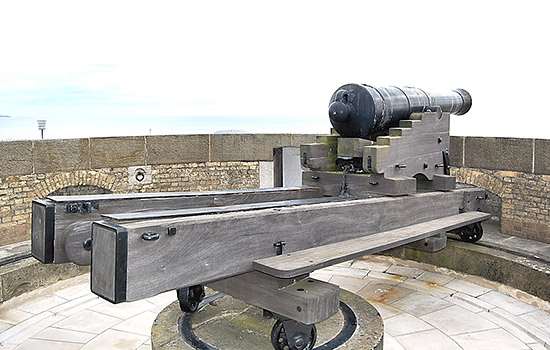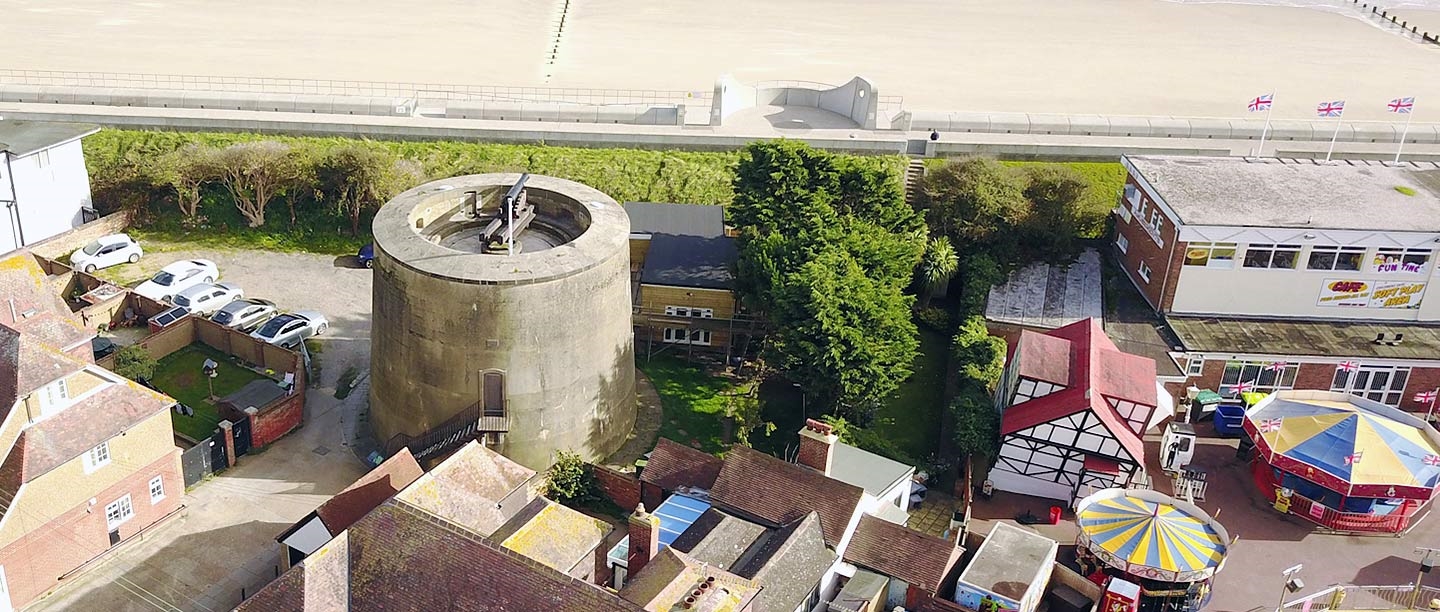The threat of invasion
Between 1793 and 1802, Britain was involved in two European coalitions fighting against Revolutionary France. Armed conflict ended in 1802 but the fundamental differences were not resolved, and in 1803 Britain went to war with France again.
With his attention now focused on Britain, Napoleon Bonaparte began to assemble ‘the Army of the Ocean Coasts’ in the area around Boulogne on the Channel coast. French shipbuilders made barges to transport this army across the English Channel, while Napoleon considered how he might defeat or elude the Royal Navy to deliver his soldiers onto English soil.
From 1793, the British government had improved coastal defences and increased the size of its army by raising volunteers. But in 1803 much remained to be done – army numbers were about 30,000 short of the French 160,000. With such an imminent threat, planning began on measures to prevent the French from landing and then capturing a major port from which their army might be re-supplied.
The clear objective of the French was to capture London, the heart of the nation. There were several potential locations for a landing. The most likely were in the south-east, including the port of Dover and beaches west of it as far as Eastbourne, and on the east coast, including the deep-water port of Harwich and the long beaches north and south of it in Suffolk and Essex. To cover these possibilities, the government began to build defences to protect both areas.
The nation prepares
In 1803, the government consulted military experts about the idea of building gun towers at vulnerable points along the coast. Such towers were not innovative, but their effectiveness for coastal defence had been demonstrated only a few years previously, in 1794, during fighting on the coast of Corsica. Two British warships, HMS Fortitude (74 guns) and HMS Juno (32 guns), had attacked a French-held circular tower equipped with just three guns at Mortella Point, without success, and sustained considerable damage.
The successful defence of the Mortella tower was widely reported and resulted in planning for similar towers in British-held territories, with the first examples built on Minorca, in Ireland and in Guernsey. In July 1803 Captain William Ford, the Commanding Royal Engineer at Dover, proposed building square towers along the coast of southern England, and during 1804 an alternative scheme for round towers was in circulation.
At Rochester, Kent, in October 1804, at a national defence conference, a scheme for towers was agreed in principle. Subsequently, a modified plan settled on 74 ‘Martello’ towers of elliptical form and two larger circular forts, or redoubts. The name Martello was a misspelling of Mortella.
Building the towers
Work on the south coast towers began early in 1805 and most of them – numbered 1 to 74 from east to west – were completed by 1808, though some work carried on for another two years. The new towers covered the most vulnerable stretches of beach and significant harbours, plugging gaps between existing gun batteries and forts built from 1793 onwards, for instance at Dungeness. There were three main concentrations – between Folkestone and Dungeness, along Winchelsea Beach, and between Rye and Eastbourne. There was a solitary tower further west, at Seaford.
The towers had to be built quickly, although the immediate threat of invasion was over late in 1805. Nevertheless, a possible threat remained until 1812 and work on defences continued.
The work was under the general supervision of Major General William Twiss, who was the military engineer in charge of the entire Southern District. It may have been one of his officers, William Ford, who drew up and refined the tower design.
The construction work was given to a civilian contractor, the London builder William Hobson, who subcontracted some of the work to two others, John ‘Yorky’ Smith and Edward Hodges. Each tower required about 250,000 bricks, a colossal quantity to produce and transport. Many came by ship from brick makers around London and in south-east England, while some were made from clay dug more locally, notably at several sites along the Sussex coast.
The Dymchurch tower
Martello tower 24 is one of six at or close to Dymchurch, of which three survive. It stands on the eastern side of the Marshland Sluice, one of the main drainage outfalls that regulate the water level in Romney Marsh – an area of low-lying flat land kept dry by large drains, and defended from the sea by high artificial banks (notably Dymchurch Wall) and the massive shingle spit of Dungeness. Tower 25 is only 260 metres (285 yards) away on the other side of the outfall.
The two towers were intended to prevent the enemy from taking control of the outfall if they landed on the adjacent beaches. Such control would have stopped the defenders from flooding Romney Marsh in order to prevent the French army from crossing it – though even at the time many thought such flooding could not have been done quickly enough. On the other hand, by opening the sluice, the French might have affected the defensive usefulness of the Royal Military Canal, which was part of the drainage system.
Tower 24 is a standard south coast Martello design. It is elliptical in plan (see top image) and 10 metres (33 feet) high, its walls tapering from a base of about 14.5 metres (48 feet) diameter to a slightly narrower top. The brick walls, rendered on the outside, are immensely strong, being thicker on the seaward side to deflect incoming cannon shot. The whole structure is vaulted, the round vault supporting the roof and carried on a large central brick pier.
The solitary entrance is a doorway at first-floor level, originally reached by a retractable ladder to prevent a forced entry by the enemy. This level was for the accommodation of the garrison and has two small windows and two coal fireplaces. The ground floor, reached through a trapdoor and stair from the first floor, was for storage of gunpowder, coal, water and food. A quadrant of the ground floor is partitioned by a brick wall to form a magazine, where gunpowder barrels were stored.
The flat roof, open to the sky and surrounded by a thick parapet, is approached from the first floor up a stair built in the wall thickness. It supported a single 24-pounder gun.
The east coast towers
To protect the east coast, between 1809 and 1812 another 29 Martello towers were constructed at strategic locations along the 60-odd mile coastline between Point Clear, near St Osyth (Essex), and Aldeburgh (Suffolk).
These towers were significantly larger than their south coast predecessors, with diameters of about 16.8 metres (55 feet), but about the same height. Inside, the essential arrangements for the garrison were similar, though there were two staircases instead of one in the wall thickness, linking the first floor to the gun platform. Whereas the south coast towers were elliptical, the east coast Martellos were cam shaped (like a rounded triangle). Their quatrefoil-shaped gun platforms accommodated three guns, with an open rectangular area at the rear where a doorway led to the stairs.
With three smoothbore guns – a 24-pounder (to target ships) and either two 24-pounder carronades or two 5.5-inch howitzers (to target troops at closer range) – the east coast towers were more powerful than those on the south coast.
Image: An aerial view of Tower W at Bawdsey in Suffolk, showing the distinctive quatrefoil gun platform. The modern glass building, in the fourth segment of the quatrefoil, covers the entrance to the stairs (© Historic England Archive)
Life in the tower
Each tower was intended for a garrison of 25 men – one officer and 24 other ranks. Ideally, these were to be regular gunners to operate the 24-pounder gun, but in practice such men were in short supply. Some towers may have had a few regulars – often veterans and ‘invalids’ – but most probably housed militia (who were raised by ballot, trained in peacetime and called up in wartime) or volunteers. Volunteer artillery units were raised and served in the Hythe and Romney areas between 1797 and 1802. William Pitt the Younger, as Lord Warden of the Cinque Ports, revived them in 1803 as a single regiment of Cinque Ports Volunteers, and some may have served in the towers. The Fife Militia, from Scotland, were at Dymchurch in 1806–7, and probably occupied or guarded tower 24.
The first-floor accommodation was divided by radial partitions into three – a room for the officer, a tiny room for a quartermaster, and a room for all the men. The officer’s room was only slightly smaller than the men’s, who would have been tightly packed. However, such cramped and unpleasant quarters would probably have been taken up fully only in emergencies. Ordinarily, there was probably a system with smaller detachments of men on alternate watches, while those off duty may have stayed in local inns.
The armament
The men had smoothbore flintlock muskets as their personal weapons, but the main armament of tower 24 was a 24-pounder smoothbore gun. This powerful gun could fire solid iron round shot, 5½ inches (14cm) in diameter and weighing 24 lb (11kg), at ships over a mile (1.6km) away. It was also equipped to attack troops attempting to land with case shot – a tin canister that disintegrated on firing, releasing a lethal shower of up to 84 small iron or lead balls.
The gun was mounted on a wooden carriage, which in turn sat on a ‘traversing’ wooden platform that enabled it to turn through 360 degrees. Its surface was inclined upwards to the rear. On firing, this incline served as a brake on the recoiling gun, bringing it to rest at the rear of the platform for reloading.
The gun now at Dymchurch is a genuine 24-pounder, cast sometime between 1792 and 1815, but it is not the actual gun mounted here during the Napoleonic War, which was withdrawn in 1817. The wooden slide carriage and traversing platform are replicas of an 1860s design: the original carriage was not a slide but a garrison type, with four small truck wheels.
The Coast Blockade and Coastguard
An invasion did not come, and the towers never saw any fighting. At the end of the Napoleonic War in 1815, the garrisons were disbanded, and the towers were disused, with only a caretaker to look after them. Towers 1 to 27 had all been disarmed by 1817, with the guns, carriages and platforms removed to storage. However, a new use was quickly found for some of the towers, including tower 24.
In 1816 a new naval force was created to combat smuggling, which was commonplace along the coast of Kent and Sussex. Known as the Coast Blockade, it conducted patrols in small ships and boats at sea and foot patrols on shore. Small detachments occupied coastal buildings and several Martello towers were made available to them.
Martello tower 24 was a Coast Blockade station from 1819, possibly earlier, and continued as such until 1832. It was a small naval barracks, usually for one officer (occasionally two) and between eight and thirteen ratings. In some stations, the ratings (non-officers) could have women living with them.
Patrol work and intercepting smuggling gangs were dangerous. The gangs were large, well-armed and ruthless and often enjoyed support from local people who benefited from their activities. One infamous band, the Aldington Gang, operated from the area of Romney Marsh until its members were finally brought to justice in 1826. In April 1830, Lieutenant Gustavus Baker from Martello tower 23 and Sentinel Martin Donovan of tower 24 were severely wounded in the head and legs in a fight at Dymchurch Wall.
In 1832 the Coastguard took over the activities of the Coast Blockade and tower 24 became a Coastguard station. By 1856, smuggling had been brought under control, and the Coastguard became a naval reserve force, still watchful of smuggling, but also involved in lifesaving at sea. Until the late 1880s, the station had up to four Coastguard families in residence, after which they lived in new cottages, while the tower remained as an active station until the mid 20th century.
During the Second World War, the tower had brief periods of use by army units preparing, like their predecessors 140 years earlier, to defend against an invasion. On 13 June 1944, observers at the Royal Observer Corps Post located on top of the tower reported the first V1 flying bomb to enter the UK.
By the late 1950s, an appreciation of the importance of Martellos in the history of English defences led the Ministry of Works to acquire tower 24 from the War Office when it became surplus to Coastguard requirements. Extensively restored over the following decade, it opened as a museum in 1969. It is now in the care of English Heritage and managed by the Friends of Martello24.
By Paul Pattison
Find out more
Further reading
WH Clements, Towers of Strength: Martello Towers Worldwide (London, 1999)
JG Coad, Dymchurch Martello Tower (English Heritage guidebook, London, 1990)
R Glover, Britain at Bay: Defence against Bonaparte, 1803–14, esp ch 5 ‘Fortifications’ (London, 1973)
R Knight, Britain against Napoleon: The Organization of Victory, 1793–1815, esp ch 9 ‘The Invasion Threat’ (London, 2013)
R Philp, The Coast Blockade: The Royal Navy's War on Smuggling in Kent and Sussex, 1817–31 (Horsham, 1999)
SGP Ward, ‘Defence works in Britain 1803–5’, Journal of Army Historical Research, 27 (1949), 18–37
-

Visit the tower
This is one of a chain of ingeniously designed artillery towers built around the south and east coasts of England from 1805 to protect against the threat of invasion by Napoleon.
-

Friends of Martello24
More information on Dymchurch Martello tower is available on the Friends of Martello24 website.
-

The Lords Warden of the Cinque Ports
The Lord Warden of the Cinque Ports was once a powerful role, responsible for the defence of Kent and Sussex. Learn about some of the most famous Lords Warden.
-

MORE HISTORIES
Delve into our history pages to discover more about our sites, how they have changed over time, and who made them what they are today.
